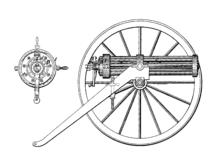Ripley machine gun

The Ripley Machine Gun was a volley gun, an early precursor of the machine gun, patented in 1861 by Ezra Ripley.[1] Although it was likely never actually produced, it demonstrated a number of basic concepts that were employed in the design of the Gatling Gun that was patented the following year.
Method of action
The design, as patented, consists of nine fixed barrels attached to a limbers and caissons. The weapon is loaded with a cylinder containing nine rounds of ammunition, arranged so that the rounds line up with the barrels of the weapon. A firing handle is then attached, locking the cylinder into place.
The weapon was fired by rotating the handle, the barrels firing in sequence. By rotating the handle quickly a high rate of fire could be achieved, or slowly, single shots. Once the nine rounds of ammunition in the chamber were expended, the cylinder could be removed for reloading and a fresh cylinder could be inserted into the breech.
The weapon was most probably never built,[2] and was passed over in favor of volley guns like the Billinghurst Requa Battery.
References
- George M. Chinn, The Machine Gun, Volume I, 1951
Notes
- ↑ Google patent entry for the Ripley machine gun
- ↑ George M. Chinn, The Machine Gun, Volume I, 1951